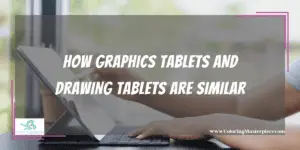If you are interested in any form of graphic design or just want to pick up digital drawing as a hobby then you are bound to run into the issue of whether you want a graphics tablet or a drawing tablet. With names like those, it is no wonder most people assume they are the same thing.
While these two devices accomplish the same goal, the way that they do so is different enough that you need to understand everything they have to offer before deciding what works best for you. Read on to learn the differences, pros, and cons of each device as well as what each one is best for.
How Graphics Tablets and Drawing Tablets are Similar

Let’s start by mapping out the similarities of the two to create a basis before diving into the differences. Both graphics tablets and drawing tablets use touch technology to translate what you are drawing into a digital image. You can use a tool like a stylus, or drawing tablets, and the newer generation of graphics tablets support your hand to draw.
These surfaces are also pressure-sensitive, so you can use varying pressure to create different strokes and weights. This is a major difference between entry-level drawing software that only allows lines of uniform width. Graphics tablets and drawing tablets are specifically designed to mimic drawing on paper. You might have a surface with the same texture as drawing paper, and most of these tools also support tilt sensitivity that adapts drawings to several mediums.
Graphics Tablet
A graphics tablet is a hardware input device that you connect to a computer, laptop, or another screen to create digital art.
Features
Graphics tablets are made up of a drawing surface, hotkeys, and a specialized stylus. Starting with the drawing surface, graphics tablets tend to have a larger surface that is pressure sensitive and responds to styluses to record lines and curves. The surface also includes a separate section for hotkeys that can perform different functions that differ from device to device.
Most graphics tablets need a stylus to work, and some may require you to use a specific type. These styluses are designed with graphics tablet compatibility in mind, and if you plan on upgrading then you want one that is wireless and feels good in your hand.
Pros
Because graphics tablets only include hardware for the input you have a cheaper buy-in price. This works great if you already have a computer or a monitor that you can use with the graphics tablet. Graphics tablets are very responsive, and you might find that drawing with one is more accurate than with a drawing tablet. If your work deals a lot with accuracy then a cheaper graphics tablet can get the job done easier than a more expensive drawing tablet.
Graphics tablets are more durable and require fewer repairs because they do not feature a fragile screen. They are more resistant to dust and water that easily damages electrical components, and a graphics tablet can keep you satisfied for up to 10 years before you will want to replace it.
Cons
The fact that you cannot use a graphics tablet without an additional screen limits you in a few areas. This takes quite a bit of getting used to. From the time we are children we learn to draw and color by looking at the same surface we are working on. With a graphics tablet, you need to teach your brain to draw at the same level while looking in a different location.
This can also require you to buy an additional screen or computer to use with the graphics tablet if you do not have one yet, adding to the price tag. A graphics tablet can be easier to transport because of its size and durability, but if you need to bring along a laptop then you are adding to the list of technology you need to carry around.
Check out these 10 practical gifts for adults who love to color!
Drawing Tablet
Drawing tablets, also known as pen displays or pen tablets, are input software that includes a computer screen as the drawing surface.
Features
The main feature of a drawing tablet is its responsive visual screen. Drawing tablets have the same main parts as a graphics tablet:
- A screen
- Hotkeys
- A stylus
The screen on a drawing tablet lets you look at what you are drawing, and it responds to you in a similar way that paper or canvas surfaces would. You do not need to connect to another screen to use the drawing tablet, and you can save your progress on the drawing tablet as well.
The hotkeys of a drawing tablet are more commonly on the screen, and you can find more advanced menus hooked away in the software. Graphics tablets have these same features, but not everything links back to the hotkeys. A drawing tablet can use a wider variety of styluses, and more of them support using your fingers to draw. Styluses are still preferred for professional or serious drawing because they come with a greater variety of features and accuracy.
Pros
A major benefit of using a drawing tablet is your ability to see what you are working on. This is closer to how our brains are wired and how we develop our artistic abilities, so there is less of a learning curve involved. Because you can see what you are working on the drawing process is much faster with a drawing tablet. The interface is much more intuitive and keeps everything in one area.
Drawing tablets are more portable because the screen is the same as the drawing surface. In most cases, you only need to pack away the tablet and a stylus and you are good to go. You can also use some tablets for more than drawing. You can utilize drawing software on regular tablets to turn them into drawing tablets and keep more tools in one location, or you can load non-drawing software onto certain drawing tablets.
Cons
Drawing tablets are not nearly as durable as graphics tablets. The handy glass screen is more likely to be damaged from pressure over time, and it is too easy to crack the drawing surface if you drop it or set anything on top of it. Drawing tablets are also more expensive because they use a greater variety of parts, but costs are coming down as they gain popularity. The problem with that is that drawing tablets are constantly advancing and have not hit a sweet spot where you can comfortably sit with an outdated device. You are likely to want to replace a drawing tablet in a maximum of 5 years, but you could easily break the device in a shorter period than that.
Which Drawing Tool Is Best for You

Either one can work well with your situation, and it mostly comes down to budget. A graphics tablet is a more cost-effective choice, but this also depends on whether you have a computer you can link it up to. Drawing tablets can be a tablet you already own that you dedicate to drawing, but buying one new can put a dent in your budget.
If price is not a major concern then try to get your hands on a few of these devices to see which one works best for you. Some prefer the graphics tablet because it feels more like paper and tends to have better accuracy. Drawing tablets are easier to learn, and you might benefit from a greater variety of tools.
Maximize the benefits of coloring with my free adult coloring eBook and by signing up for my email newsletter HERE!
Disclaimer: The information provided by ColoringMasterpiece.com (“The Site”) is for general informational purposes only. All information on the Site is provided in good faith, however, we make no representation or warranty of any kind, express or implied, regarding the accuracy, adequacy, validity, reliability, availability, or completeness of any information on the Site. Under no circumstance shall we have any liability to you for any loss or damage of any kind incurred as a result of the use of the Site or Reliance on any information provided on the Site. Your use of the Site and your reliance on any information on the Site is solely at your own risk. This blog post is for educational purposes only and does not constitute legal advice. Please consult a legal expert to address your specific needs.
Terms and Conditions: https://coloringmasterpiece.com/terms-and-conditions/

